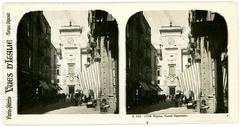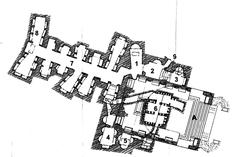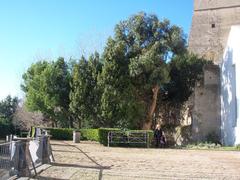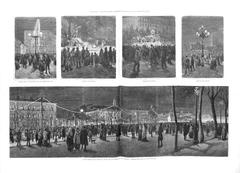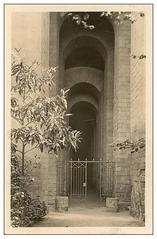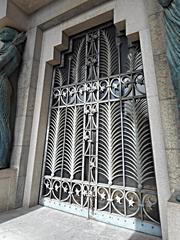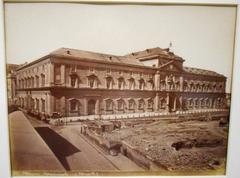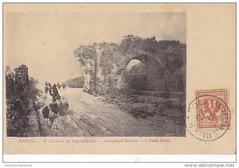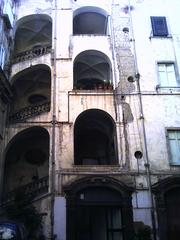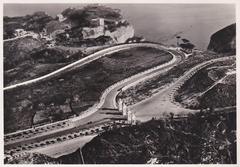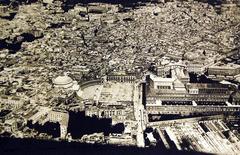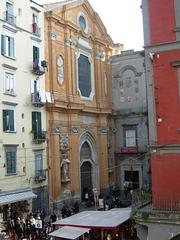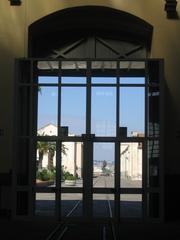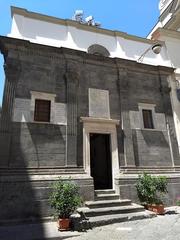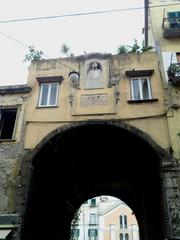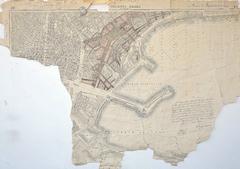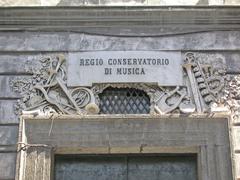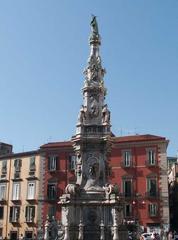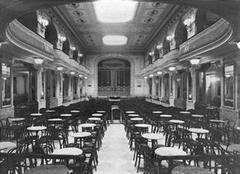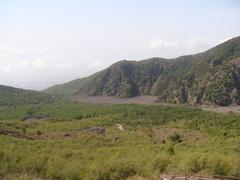Visiting Porta Capuana: History, Tickets, and Tips for Naples
Date: 18/07/2024
Introduction
Porta Capuana, a monumental gate in Naples, Italy, stands as a testament to the city’s rich historical and architectural heritage. Constructed in 1484 during the reign of Ferdinand I of Aragon, this remarkable structure was designed by the renowned architect Giuliano da Maiano. Serving as a primary entrance to Naples from the east, specifically from the direction of Capua, it showcases a blend of Renaissance and Gothic architectural elements. The two massive cylindrical towers, Torre della Brava and Torre della Virtù, were designed for robust defense, while the central archway adorned with intricate carvings and reliefs highlights the artistic prowess of the period (Naples Tourist Guide, Italy Magazine).
Throughout its history, Porta Capuana has played significant roles, from its defensive capabilities during the Aragonese period to its enhancements under Spanish rule in the 16th century (Spanish Naples). Despite falling into disrepair by the 19th century, restoration efforts in the late 19th and early 20th centuries preserved its architectural integrity (Restoration Projects). Today, Porta Capuana is a popular tourist attraction and a focal point for cultural events, symbolizing Naples’ enduring historical and cultural significance (Naples Tourism).
Table of Contents
- Origins and Construction
- Architectural Significance
- Role in the Aragonese Period
- Spanish Influence and Modifications
- Decline and Restoration
- Modern-Day Significance
- Archaeological Discoveries
- Cultural Impact
- Preservation Efforts
- Visiting Porta Capuana
- FAQ
Exploring Porta Capuana - History, Visiting Hours, Tickets, and Travel Tips
Origins and Construction
Porta Capuana, one of the most significant historical landmarks in Naples, Italy, was constructed in 1484 during the reign of Ferdinand I of Aragon. Designed by renowned architect Giuliano da Maiano, it served as a primary entrance from the east, specifically from Capua, hence its name (Naples Tourist Guide).
Architectural Significance
The architectural style of Porta Capuana blends Renaissance and Gothic elements, reflecting the transitional period in which it was built. The gate is flanked by two massive cylindrical towers, “Torre della Brava” and “Torre della Virtù,” designed for robust defense. The central archway features intricate carvings and reliefs, showcasing the artistic prowess of the era (Italy Magazine).
Role in the Aragonese Period
During the Aragonese period, Porta Capuana was not only a defensive structure but also a symbol of the city’s prosperity and strategic importance. It was part of a larger fortification system designed to protect Naples from external threats. The Aragonese rulers heavily invested in the city’s infrastructure, with Porta Capuana standing as a testament to their commitment (Naples History).
Spanish Influence and Modifications
In the 16th century, under Spanish rule, Porta Capuana underwent several modifications to enhance its defensive capabilities. The Spanish rulers recognized the strategic importance of Naples and sought to strengthen its fortifications. The gate was reinforced with additional masonry, and the surrounding area was restructured to improve its defensive posture (Spanish Naples).
Decline and Restoration
By the 19th century, the defensive role of Porta Capuana had diminished due to advancements in military technology and changes in warfare. The gate fell into disrepair, but recognizing its cultural and historical value, restoration efforts were initiated in the late 19th and early 20th centuries to preserve its architectural integrity (Restoration Projects).
Modern-Day Significance
Today, Porta Capuana stands as a symbol of Naples’ rich history and architectural heritage. It is a popular tourist attraction, drawing visitors from around the world eager to explore its historical and architectural significance. The gate also serves as a focal point for cultural events and activities (Naples Tourism).
Archaeological Discoveries
Recent archaeological excavations around Porta Capuana have unearthed significant findings, including remnants of the original fortifications and artifacts from the Aragonese and Spanish periods. These discoveries provide valuable insights into the construction techniques and materials used, as well as the gate’s strategic importance throughout history (Archaeological Journal).
Cultural Impact
Porta Capuana has had a profound impact on the cultural landscape of Naples. The gate has been featured in numerous works of art, literature, and film, symbolizing the city’s resilience and historical significance. It has inspired artists and writers for centuries, serving as a muse for creative expression (Cultural Studies).
Preservation Efforts
Ongoing preservation efforts are crucial to maintaining the historical and architectural integrity of Porta Capuana. These efforts involve regular maintenance, structural assessments, and conservation projects aimed at protecting the gate from environmental and human-induced damage. Preservationists work closely with local authorities and international organizations to ensure that Porta Capuana remains a cherished landmark for future generations (Preservation Society).
Visiting Porta Capuana
Porta Capuana is open to the public year-round, typically from 9:00 AM to 6:00 PM daily. It’s best to check current schedules as they can vary seasonally or due to special events (Naples Historical Sites).
Ticket Information
Admission to Porta Capuana is generally free, although certain special exhibitions or guided tours might require a ticket. It’s advisable to check the official website or contact local tourist information centers for the most current ticket prices and available tours (Porta Capuana Tickets).
Travel Tips
- Accessibility: The site is accessible via public transportation, with several bus and metro lines stopping nearby. Check local transit maps and schedules.
- Nearby Attractions: Porta Capuana is near several other notable historical sites, including Castel Capuano and the Naples Cathedral. Explore these nearby attractions to make the most of your visit.
- Guided Tours: Consider joining a guided tour to gain deeper insights into the history and significance of Porta Capuana. Many tours can be booked online in advance.
- Special Events: Look out for cultural events and activities held at Porta Capuana, which provide a unique opportunity to experience the site in a different context (Naples Travel Tips).
Educational Programs
Educational programs and guided tours are available for visitors interested in learning more about the history and significance of Porta Capuana. These programs provide in-depth information about the gate’s construction, its role in the city’s defense, and its cultural impact. They also highlight the ongoing preservation efforts (Educational Tours).
FAQ
What are the visiting hours for Porta Capuana? Porta Capuana is generally open from 9:00 AM to 6:00 PM daily. However, visiting hours may vary, so it’s advisable to check current schedules before planning your visit.
How much are tickets to Porta Capuana? Admission to Porta Capuana is usually free. Special exhibitions or guided tours may require a ticket. Check the official website or local tourist information centers for the most up-to-date ticket prices.
Is Porta Capuana accessible by public transportation? Yes, Porta Capuana is easily accessible via public transportation, with several bus and metro lines stopping nearby.
Are there guided tours available at Porta Capuana? Yes, guided tours are available and can provide valuable insights into the site’s history and significance. It’s recommended to book tours in advance.
Conclusion
Porta Capuana is more than just a historical gate; it is a symbol of Naples’ rich history, architectural heritage, and cultural significance. Its origins, architectural features, and role in the city’s defense make it a fascinating subject for study and exploration. Ongoing preservation efforts and educational programs ensure that Porta Capuana remains a cherished landmark that connects the past with the present, offering valuable insights into the history and culture of Naples (Naples Historical Sites).
References
- Naples Tourist Guide. (n.d.). Exploring Porta Capuana - History, Visiting Hours, Tickets, and Travel Tips. naplestouristguide.com
- Italy Magazine. (n.d.). Porta Capuana. italymagazine.com
- Naples History. (n.d.). Aragonese Period. napleshistory.com
- Spanish Naples. (n.d.). Fortifications. spanishnaples.com
- Restoration Projects. (n.d.). Porta Capuana. restorationprojects.com
- Naples Tourism. (n.d.). Porta Capuana. naplestourism.com
- Archaeological Journal. (n.d.). Recent Archaeological Discoveries at Porta Capuana. archaeologicaljournal.com
- Cultural Studies. (n.d.). Cultural Impact of Porta Capuana. culturalstudies.com
- Preservation Society. (n.d.). Preservation Efforts for Porta Capuana. preservationsociety.com
- Naples Historical Sites. (n.d.). Visiting Porta Capuana. napleshistoricals.com
- Porta Capuana Tickets. (n.d.). Ticket Information. portacapuanatickets.com
- Naples Travel Tips. (n.d.). Travel Tips for Porta Capuana. naplestraveltips.com
- Educational Tours. (n.d.). Educational Programs at Porta Capuana. educationaltours.com


